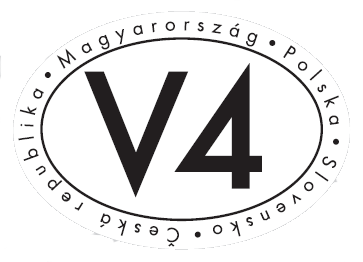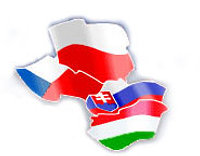Project Publications
| Book 1 | Book 2 | Book 3 | Book 4 | Book 5 | Book 6 | conference articles in journals |
Daszkiewicz, N., & Olczyk, M. (2014). Competitiveness of the Visegrad Countries – Paths for Competitiveness Growth (chapter 2) In: D. Kiendl-Wendner & K. Wach K. (Eds.), International Competitiveness in Visegrad Countries: Macrto and Micro Perspective. Graz: Fachhochschule Joanneym (ISBN: 978-3-200-03673-4).
Full text: pdf (free download)
Abstract
The article includes two objectives: 1) to determine competitiveness of the Visegrad Countries in terms of 12 pillars of competitiveness used by The Global Competitiveness Report of the Wold Economic Forum (WEF) (Schwab, 2013), 2) to propose taxonomic method to appoint a path of competitiveness growth of economies. The following research methods were applied: literature review and two taxonomic methods i.e. cluster analysis and an object map, based on the matrix of distances. On the basis of the results, we propose a new approach to appoint a path of competitiveness growth for each Visegrad country. Statistical analyses in this article are performed using the statistical software Statistica v. 11.0, SPSS v. 21.0 and R v. 3.1.0. The analysis based on 12 competitiveness pillars of the Visegrad Countries indicates their high diversity of competitiveness level both in terms of their position in the ranking and the fundaments of competitiveness. However, the taxonomic cluster analysis conducted for 78 most competitive economies and based on unweighed values of 12 competitiveness pillars indicates that the Visegrad Group is the area with a relatively small differentiation in terms of competitiveness fundaments. The analysis shows that the strategy to increase competitiveness should not be significantly different for each Visegrad country. It is suggested that in order to increase its international competitiveness each Visegrad country should follow the pattern of the country which stands above it (in terms of competitiveness ranking), and at the same time to the one which is most similar. Thus, for Slovakia, Hungary or the Czech Republic following Polish experiences could be the best solution. We propose a new approach to appoint a path of competitiveness growth of economies and to determine the competitiveness growth direction for Visegrad Countries.
Keywords: international competitiveness, Visegrad Countries (V4), Central Europe, growth
JEL classification: F00
References
Cho, D.S. (1994). A dynamic approach to international competitiveness: the case of Korea. Journal of Far Eastern Business, 1 (1), pp. 17–36.
Cho, D.S., & Moon, H.C. (2000). From Adam Smith to Michael Porter. Singapore: World Scientific.
Cho, D.S., & Moon, H.C., & Kim, M.J. (2008). Characterizing international competitiveness in international business research: A MASI approach to national competitiveness, Research in International Business and Finance, 22, pp. 175–192.
Daszkiewicz, N. (ed) (2008). Konkurencyjność: poziom makro, mezo, mikro. Warszwa: Wydawnictwo Naukowe PWN.
Daszkiewicz, N. & Olczyk, M. (2008). Konkurencyjność podmiotów – ujęcie teoretyczne (chapter 1), In: N. Daszkiewicz (ed.), Konkurencyjność: poziom makro, mezo, mikro. Warszawa: Wydawnictwo Naukowe PWN.
Daszkiewicz, N. & Wach K. (2013). Małe i średnie przedsiębiorstwa na rynkach międzynarodowych, Kraków: Wydawnictwo Uniwersytetu Ekonomicznego w Krakowie.
Dunning, J.H. (1993). Internationalizing Porter’s Diamond, Management International Review, 33, pp. 7-15, special issue “Extensions of the Porter Diamond Framework”.
Everitt, B. S., & Landau, S., & Leese, M. (2001). Cluster Analysis. London: Edward Arnold.
Kaufman, L., & Rousseeuw, P. J. (1990). Finding Groups in Data. New York: John Wiley & Sons.
Krugman, P.R. (1990). Rethinking International Trade. Cambridge, MA: MIT Press.
Krugman, P.R. (1992). Does the new trade theory require a new trade policy?, World Economy, 5(4), pp. 423-442.
Krugman, P.R. & Obstfeld, M. (2003). International Economics: Theory and Policy, 4th edition. New York: HarperCollins.
Milligan G., & Cooper M. (1985). An Examination of Procedures for Determining the Number of Clusters in a Data Set. Psychometrika, 50.
Molendowski, E. & Żmuda, M. (2013). Changes In Competitiveness Among The Visegrad Countries After Accession To The European Union: A Comparative Analysis Based On A Generalized Double Diamond Model, Comparative Economic Research, 16(4), pp. 121-153.
OECD, (1992). Programme on Technology and the Economy. Paris.
Olczyk, M. (2008). Konkurencyjność. Teoria i praktyka, Warszawa: CeDeWu Wydawnictwa Fachowe.
Porter, M.E. (1990). The Competitive Advantage of Nations. New York, NY: Free Press, MacMillan.
Porter, M.E. (1998). Clusters and the new economics of competition. Harvard Business Review, 76(6), pp. 77–90.
Porter, M.E. (2000). Location, competition, and economic development: local clusters in a global economy. Economic Development Quarterly, 14(1), pp. 15–35.
Porter, M.E. (2003). The economic performance of regions. Regional Studies, 37, pp. 549–578.
Schwab, K. (ed.) (2013). The Global Competitiveness Report 2013-2014: Full Data Edition. Geneva: World Economic Forum.
Smit, A.J. (2007). The competitive advantage of nations: is Porter’s Diamond Framework a new theory that explains the international competitiveness of countries?, Sothern Africa Business Review, 14(1), pp. 105-130.
Wysokińska, Z. (2001). Konkurencyjność w międzynarodowym i globalnym handlu technologiami. Warszawa-Łódź: PWN.
Czech Republic
Hungary
Poland
Slovakia

Contact:
Dr hab. Krzysztof Wach
Cracow University of Economics
wachk@uek.krakow.pl
www.wach.uek.krakow.pl

